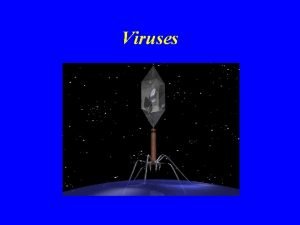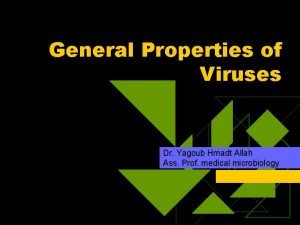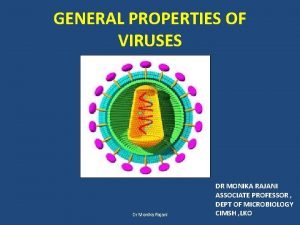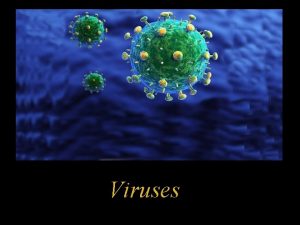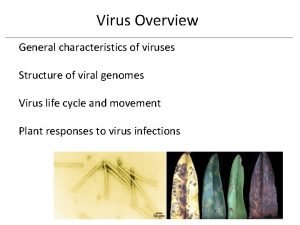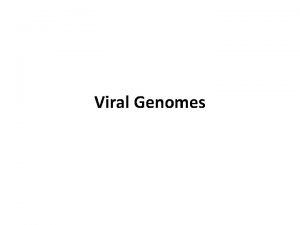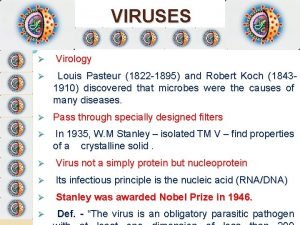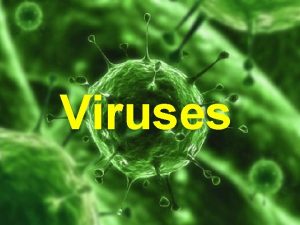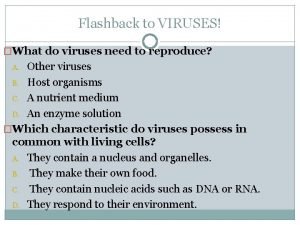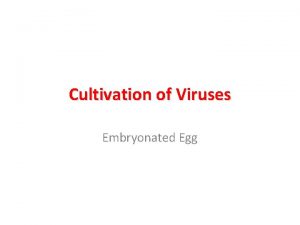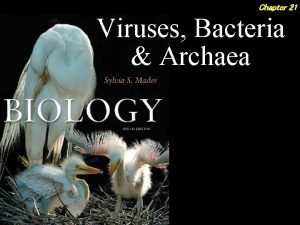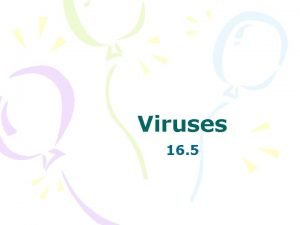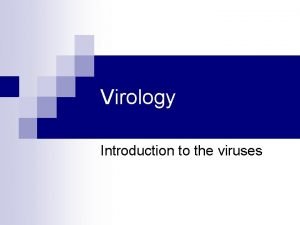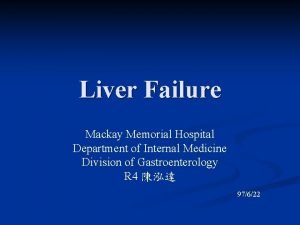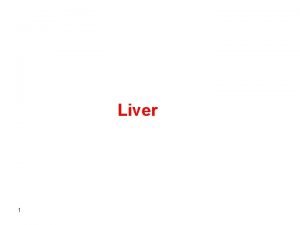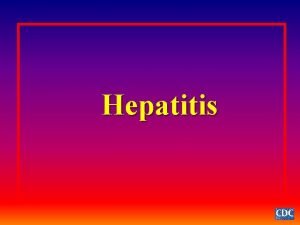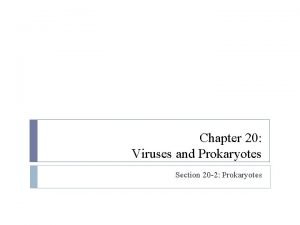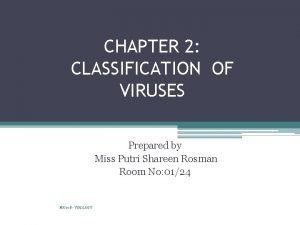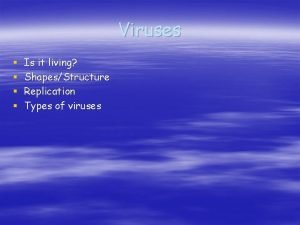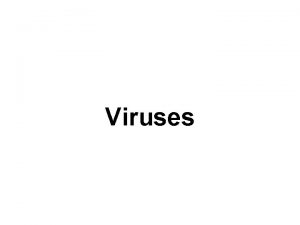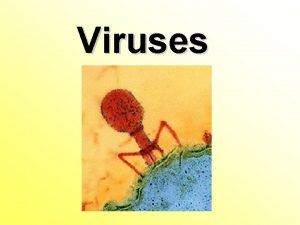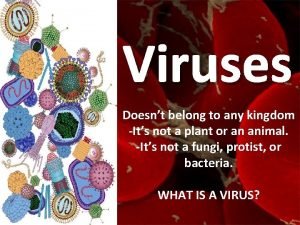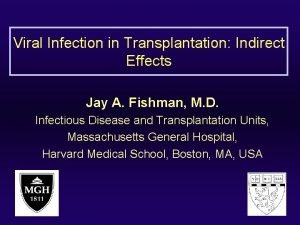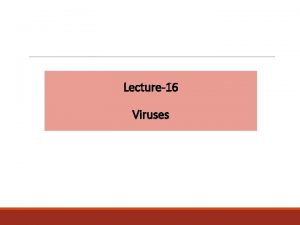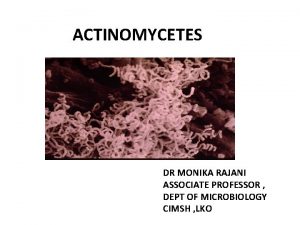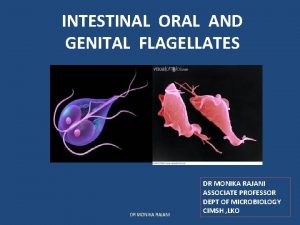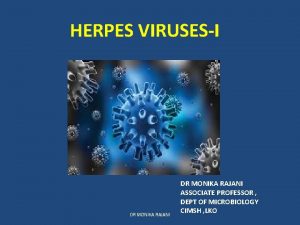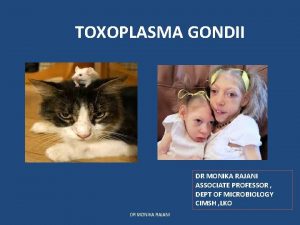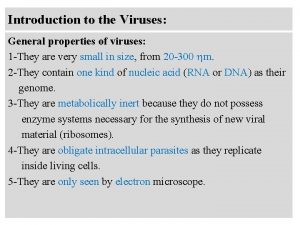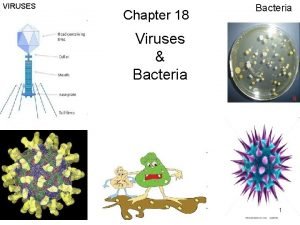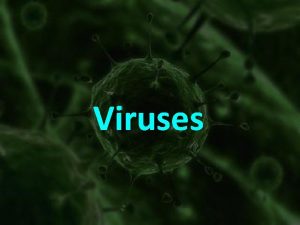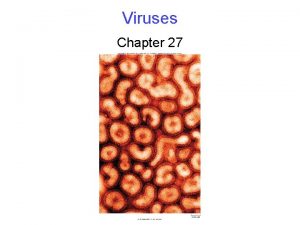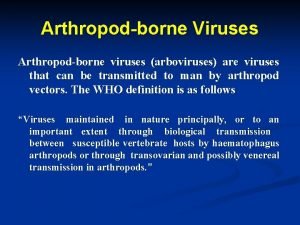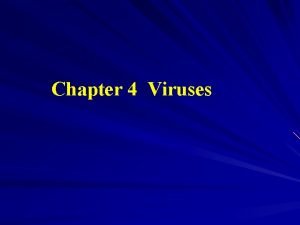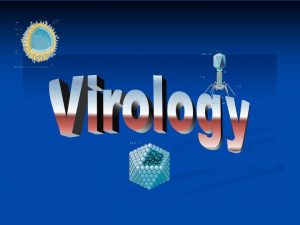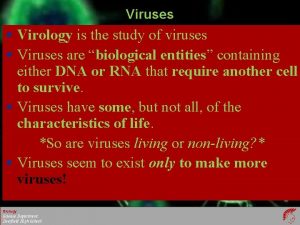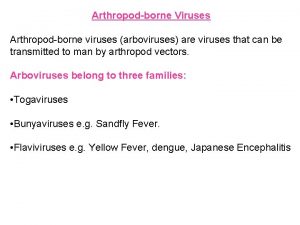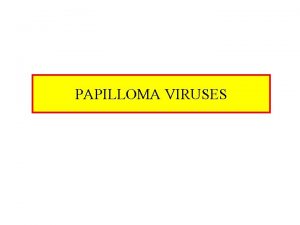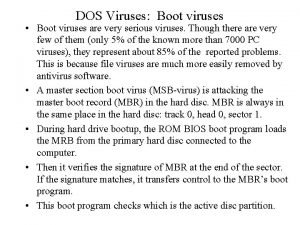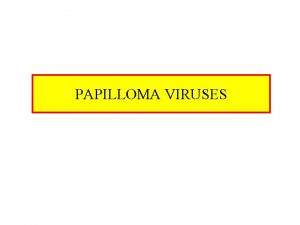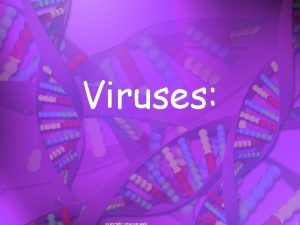GENERAL PROPERTIES OF VIRUSES Dr Monika Rajani DR





































- Slides: 37

GENERAL PROPERTIES OF VIRUSES Dr Monika Rajani DR MONIKA RAJANI ASSOCIATE PROFESSOR , DEPT OF MICROBIOLOGY CIMSH , LKO

Dr Monika Rajani

VIRUSES • • Neither prokaryotes nor eukaryotes No cellular organisation. Contain either DNA or RNA but neither both. Obligate intracellular parasites Lack enzymes necessary for protein and nucleic acid synthesis Multiply by complex process Unaffected by antibiotics. Can cause common cold to deadly AIDS • Twilight zone that separates living from non living. Dr Monika Rajani

CHEMICALS Can be crystallisedccc as chemicalsc • Can be crystallised as chemicals Dr Monika Rajani

Dr Monika Rajani

MORPHOLOGY Smaller than bacteria(1 um: 0. 01 um) Viruses=20 -300 nm: bacteria 1000 nm Filterable Can be only seen under electron microscope except pox viruses • Smallest virus: parvovirus (20 nm) • Largest virus: pox virus (300 nm) • • Dr Monika Rajani

Dr Monika Rajani

Dr Monika Rajani

ENVELOPE • Enveloped or non enveloped(naked) • Envelope derived from host cell membrane • Lipoprotein • Lipid=host; protein=virus • Peplomeres: protein spikes projecting from envelope • Enveloped viruses are susceptible to lipid solvents. • Antigenic • Attatchment to host cell surface. • Hemagglutination Dr Monika Rajani

CAPSID • • Protein coat-polypeptide Nucleocapsid: capsid with enclosed NA Units: capsomeres The chemical units of capsids are polypeptide molecules arranged symmetrically to form an impenetrable shell around NA core • Fn: to introduce viral genome into host cell • Protects the NA from inactivation by nucleases Dr Monika Rajani

Symmetry • Icosahedral(cubical)- polygon -1 -herpes virus • Helical- spiral tube-TMV • Complex- pox viruses Dr Monika Rajani

Symmetry of capsid • Icosahedral Helical -polygon with 12 vertices and 20 sides - pentons at vertices and hexons at facets -capsomeres & NA wounded together to form helical tube Dr Monika Rajani Complex - pox viruses

Structure CHEMICAL NATURE • Nucleic acid: either DNA or RNA • Unique as nowhere else in nature nucleic information is carried solely by RNA. • Proteins • Lipids • Others: carbohydrate : enzymes Dr Monika Rajani

Definitions • Virion: Intact viral particle • Viroid: protein free subviral agent with small genome in form of low molecular weight RNA : first identified in potato spindle tuber disease • Prions: proteinaceous infectious particles without NA Dr Monika Rajani

CLASSIFICATION OF VIRUSES DNA VIRUS RNA VIRUS • ss DNA: : Parvoviridae • ds DNA : Pox viridae : Adenoviridae : Herpesviridae : Papovaviridae : Hepadnaviridae Dr Monika Rajani • • • • ss RNA: Picornaviridae Orthomyxo viridae Paramyxoviridae Flaviviridae Rhabdoviridae Bunya viridae Arena viridae Corona viridae Retroviridae Calciviridae ds RNA: Reoviridae

Shape • • • Spherical: Herpes virus Bullet shaped : Rabies virus Filamentous : Ebola virus Brick shaped : Pox virus Rod shaped: TMV Dr Monika Rajani

RESISTANCE • Heat labile • Stable at low temperatures= -70 C, lyophilisation, freeze dried • Disrupted under alkaline conditions. • Inactivated by sunlight and uv rays • Inactivated by H 2 O 2, pottasium permanganate, and hypochorites • Organic iodine compounds are actively virucidal. • Formaldehyde and BPL are actively virucidal • Hepatitis viruses and polioviruses are resistant to chlorination. Dr Monika Rajani

VIRAL HEMAGGLUTINATION • Originally observed in influenza viruses. • Property of agglutination of RBCs from different spp • Due to : : Hemagglutinin spikes on surface : Neuraminidase-RDE • Destruction of receptor leads to reversal of hemagglutination and release of virus from cell surface- ELUTION Dr Monika Rajani

VIRAL HEMAGGLUTINATION • Application: detection and assay of influenza viruses : Purification and concentration of viruses : Detection of antiviral AB by HAI test • HA also observed in measles virus, rubella, enterovirus, rabies, reovirus, parainfluenza virus Dr Monika Rajani

Viral assay • To detect virus content in a specimen • By measuring total virus particles or only infectious virions. • By counting under electron microscope • Hemagglutination titre: virus count • Types of assays of infectivity: • Quantitative: measure actual number of infectious particles. Eg- plaque assay and pock assay • Quantal: indicates only presence or absence of infectious viruses by death or CPE Dr Monika Rajani

Viral multiplication • Virus lacks biosynthetic enzymes for replication • Depend upon synthetic machinery of host cell for replication. • Steps: 1 -Adsorption- receptors on virus surface : 2 -Penetration-either whole virus or NA alone : 3 -Uncoating- release of NA in host cell : 4 -Biosynthesis of NA and capsid protein -transcription of m RNA -Translation of early proteins: ENZYMES -replication of NA -synthesis of late proteins: components of daughter virions Dr Monika Rajani

Viral multiplication • 5 -Maturation-assembly of daughter virions • 6 -Release of daughter virions- lysis or budding • Eclipse phase: : from the stage of penetration till appearance of daughter virions the virus cannot be demonstrated in host cell. During this period virus remains underground • Defective viruses: genetically deficient viruses require activity of helper viruses to produce daughter virions. eg: HDV Dr Monika Rajani

STEPS OF VIRAL MULTIPLICATION Dr Monika Rajani

CULTIVATION OF VIRUSES • Viruses are obligate intracellular parasites and cannot be grown on inanimate culture medium. • Methods: : Animal inoculation : Embryonated eggs : Tissue culture Dr Monika Rajani

Animal inoculation • • White mice Infant suckling mice- Coxsachie and Arboviruses. growth indicated by death, disease or visible lesions Drawbacks: -immunity may interfere with viral growth -Animals harbour latent viruses Dr Monika Rajani

Embryonated eggs • • embryonated hens eggs used Sites of cultivation: 1 -Chorioallantoic membrane-CAM- Variola and Vaccinia 2 -Allantoic cavity-Influenza and Paramyxoviruses -cultivation of viruses for vaccine production -eg: yellow fever(17 D strain) and rabies vaccine(Flury strain) • 3 -Amniotic sac-Infuenza virus • 4 -Yolk sac- (viruses, chlamydiae and rickettsiae) Dr Monika Rajani

TISSUE CULTURE § A: Organ culture: : bits of organs Eg: tracheal ring culture for isolation of corona viruses • B: Explant culture: : minced tissue grown embedded in plasma clots • C: Cell culture: tissues are broken into component cells by proteolytic enzymes and mechanical shaking : cells suspended in growth medium Dr Monika Rajani

CELL CULTURE • Growth medium- AA, vitamins, salts, glucose, buffers, 5% CO 2, 5% fetal calf serum -antibiotics -phenol red • Cell suspension dispenced in bottles and tubes and cells adhere to glass surface • On incubation cells divide to form a monolayer sheet of cells in a week • Types of cell culture: : Primary cell culture : Diploid cell culture : Continuous cell lines Dr Monika Rajani

PRIMARY CELL CULTURE • • normal cells freshly taken from body and cultured limited growth cannot be maintained in serial culture Eg-rhesus monkey kidney : human embryonic kidney : chick embryo fibroblasts Dr Monika Rajani

Diploid cell lines • After first subculture primary cell culture becomes diploid cell culture • retain original diploid chromosome number during serial subcultivation for a limited number of times • Eg: WI 38 -human embryonic lung strain : human diplod fibroblasts Dr Monika Rajani

CONTINUOUS CELL LINES • • Derived from cancer cells Capable of continuous serial cultivation indefinetly EG: He. La: human Ca Cx HEP 2: human epithelioma larynx KB: Ca nasopharynx Mc Coy: human synovial carcinoma Vero: vervet monkey kidney cell line Dr Monika Rajani

Detection of virus growth in cell cultures • 1 -Cytopathic effect: • morphological changes in cultured cells in which viruses grow • Crenation of cells: enteroviruses • Syncitium formation: measles • Focal degeneration: herpes viruses Dr Monika Rajani

Detection of virus growth in cell cultures • • 2 -Metabolic inhibition: inhibition of cell metabolism due to virus growth no acid production change in colour of indicator 3 -hemadsorption: addition of RBCs to culture RBCs adsorb to surface of cells in case of hemagglutinating viruses Dr Monika Rajani

Detection of virus growth in cell cultures • 4 - Viral interference: to test growth of a non cytopathogenic virus by challenge with a second cytopathogenic virus • 5 -Transformation: : oncogenic viruses induce cell transformation and loss of contact inhibition. • 6 -Immunofluorescence: by staining with fluoroscent conjugated antisera Dr Monika Rajani

VIRAL GENETICS • Mechanisms of genetic modifications: • Mutations: occur during every viral infection • Recombination-occurs when two different but related viruses simultaneously infect a cell and they exchange segments of NA resulting in hybrid Dr Monika Rajani

MUTATIONS • mostly lethal • Types of mutants: : conditional lethal mutant -mutants grow in permissible conditions but are lethal in non permissible conditions : temperature sensitive mutant -permissive and restrictive temperature : host dependant mutant-permissive cells Dr Monika Rajani

THANK YOU Dr Monika Rajani
 Unlike lytic viruses, lysogenic viruses do not
Unlike lytic viruses, lysogenic viruses do not /watch?v=dckvspcd8gs
/watch?v=dckvspcd8gs Rajani shenoy
Rajani shenoy General properties of viruses
General properties of viruses Ribovirus dan deoxyribovirus
Ribovirus dan deoxyribovirus Basic properties of viruses
Basic properties of viruses Properties of viruses
Properties of viruses Bacteriophage characteristics
Bacteriophage characteristics General characteristics of viruses
General characteristics of viruses Importance of viruses
Importance of viruses General characters of viruses
General characters of viruses Why are viruses considered nonliving?
Why are viruses considered nonliving? Viruses
Viruses Lysogenic viruses do not
Lysogenic viruses do not Section 19-3 diseases caused by bacteria and viruses
Section 19-3 diseases caused by bacteria and viruses Cultivation of viruses
Cultivation of viruses Cultivation of viruses
Cultivation of viruses Egrette - chapter 21
Egrette - chapter 21 Chapter 20 viruses and prokaryotes
Chapter 20 viruses and prokaryotes Blood borne viruses
Blood borne viruses Lesson 1: viruses
Lesson 1: viruses Are viruses alive yes or no
Are viruses alive yes or no Lytic infection
Lytic infection Biosynthesis of rna viruses
Biosynthesis of rna viruses Mackay memorial hospital
Mackay memorial hospital Hepatotropic viruses
Hepatotropic viruses Hepatotropic viruses
Hepatotropic viruses Hepatotropic viruses
Hepatotropic viruses Chapter 20 viruses and prokaryotes
Chapter 20 viruses and prokaryotes Virus taxonomy
Virus taxonomy Study guide chapter 18 section 1 bacteria
Study guide chapter 18 section 1 bacteria Replication of viruses
Replication of viruses How do viruses differ from living things
How do viruses differ from living things Importance of viruses
Importance of viruses What does dna have that rna doesnt
What does dna have that rna doesnt Best viruses
Best viruses Best viruses
Best viruses Jobpair
Jobpair



